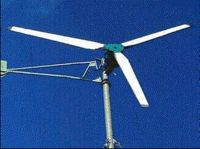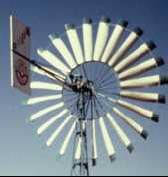No edit summary |
|||
| Line 208: | Line 208: | ||
==Water Pump== | ==Water Pump== | ||
**Materials | |||
***1 1x1/2"x30" PVC | |||
***1 1x1/2" PVC cap | |||
***1 1"x36" PVC | |||
***1 1" t-joint | |||
***1 can PVC glue | |||
***2 1"x4" PVC | |||
***2 1" PVC cap | |||
***2 1x1/2 rubber o-rings | |||
***2 3/4" check valves | |||
***1 1x1/2"male coupling | |||
***2 3/4" PVC nipple | |||
***1 3/4" t-joint | |||
***2 3/4" male threaded couplings | |||
[[Image:PATB windpumping low solidity rotor.JPG|thumb|right|200px|Figure 2: Low solidity rotor (copyleft Practical Action)]] | [[Image:PATB windpumping low solidity rotor.JPG|thumb|right|200px|Figure 2: Low solidity rotor (copyleft Practical Action)]] | ||
[[Image:PATB windpumping high solidity rotor.JPG|thumb|right|200px|Figure 3: High solidity rotor (copyleft Practical Action)]] | [[Image:PATB windpumping high solidity rotor.JPG|thumb|right|200px|Figure 3: High solidity rotor (copyleft Practical Action)]] | ||
| Line 233: | Line 247: | ||
==PVC Frame== | ==PVC Frame== | ||
**Materials | |||
***14’x1(1/2)” PVC pipe | |||
***4 (1(1/2)”)x 90 degree fittings | |||
***PVC glue | |||
***PVC saw tools | |||
***2 (size) small Buoys | |||
***Duct tape | |||
***rope line | |||
{{How to | {{How to | ||
|title= Title | |title= Title | ||
| Line 268: | Line 290: | ||
==Drum Frame== | ==Drum Frame== | ||
**Materials | |||
***55 gallon drum | |||
***sawing/cutting tools | |||
***Nails _(size) (#)_ | |||
***Wood (sizes) (#) | |||
{{How to | {{How to | ||
|title= Title | |title= Title | ||
| Line 303: | Line 330: | ||
==Inlet/Outlet system== | ==Inlet/Outlet system== | ||
**Materials | |||
***2 (3/4") caps | |||
***4 (3/4”) x 90 degree fittings | |||
***3/4” T-Valve | |||
***3/4” PVC pipe | |||
***1 (3/4”) hoes fitting | |||
***1 (3/4”) nipple threaded | |||
{{How to | {{How to | ||
|title= Title | |title= Title | ||
Revision as of 02:15, 21 April 2014

Abstract
Background
The project is an initiative by New York artist and sculptor Mary Mattingly, who designs sustainable installations and alternative living models. The WetLand bog can provide sustenance, promote increased water quality, provide habitat and will serve as a working educational platform. WetLand bog is designed to inspire environmentally friendly means to meet the challenges of coming generations. WetLand bogs seek to serve as a model for potential sustainable resource expansion and development.
Problem statement
The objective of this project is to design a floating bog to provide inspirational awareness of sustainable environmental design. The floating bog will be placed in the Delaware River alongside the WetLand facility. The floating bog will be used throughout the duration of the WetLand project in the summer of 2014.
Project Evaluation Criteria
The following Criteria will be used to assess the success of this project. These criteria were chosen based on input from the artist and the team of students who are working on the bog. The scale (1-10) represents the importance level of meeting the constraint of each listed criteria. 10 has the largest magnitude and weight decrease numerically in descending order.
| Criteria | Constraints | Weight (1-10) |
|---|---|---|
| Budget | Must be between $600-$1,000. | |
| Aesthetics | Compliment the installation and increase appeal. | |
| Vegetation | Plants must be adequate for the Delaware River regional climate, water quality, and be able to endure as it moves to New York. | |
| Education | Educational aspect compliments the overall theme of the project. | |
| Reproducibility | Can be easily recreated with readily available materials. | |
| Functionality | Utilize the appropriate and most efficient water purifying and oxygen adding plants. | |
| Materials | Recyclable materials preferred obtained from the Philadelphia area. | |
| Maintenance | Be easily maintained with little to no expertise. |
Budget
The project will require a variety of new and re-purposed materials. Many of the new materials were purchased from local business and used materials were gathered from a variety of locations throughout Arcata, CA. Donated items include PVC, lifeguard bouy, nylon rope and 2"x4" wood. Donators are listed as 'source' in table.
| Quantity | Material | Source | Cost ($) | Project Cost ($) | Total ($) |
|---|---|---|---|---|---|
| 1 | 50 gallon drum | Water Planet Garden Supply | 32.38 | 32.48 | 32.48 |
| 2 | check valve | Ace Hardware | 9.99 | 19.98 | 19.98 |
| 2 | 3/4" PVC nipple | Ace Hardware | 0.99 | 1.98 | 1.98 |
| 2 | 1.5" sch 40 Slip Cap | Ace Hardware | 1.50 | 3.89 | 3.89 |
| 1 | small screws (20) | Ace Hardware | 1.99 | 1.99 | 1.99 |
| 20 | washers | Do it Best | 0.17 | 3.40 | 3.40 |
| 4 | 90* 1x1/2 PVC | Do it Best | 2.45 | 0.00 | 0.00 |
| 2 | small screws | Do it Best | 1.19 | 2.38 | 2.38 |
| 1 | 12' nylon rope | Donated | 5.00 | 0.00 | 0.00 |
| 1 | Lifeguard Bouy | Donated | 15.00 | 0.00 | 0.00 |
| 1 | 2"x4"x28" wood | Donated | 3.68 | 0.00 | 0.00 |
| 2 | 1" Bulkhead fitting | Bayside Garden Supply | 9.95 | 19.90 | 19.90 |
| 1 | 1" Barbed insert to 1" | Bayside Garden Supply | 0.55 | 1.10 | 0.00 |
| 1 | Barbed Insert Elbow | Bayside Garden Supply | 0.55 | 1.10 | 1.10 |
| 1 | 1" Black Tubing - 1" | Bayside Garden Supply | 1.45 | 1.45 | 1.45 |
| Total Cost | $91.59 | ||||
Timeline
March
- March 2, 2014- create timeline and finish budget
- March 06-11, 2014- gather materials: plastic bottles, coconut fiber, boat, and some plants. Contact potential donors.
- March 12, 2014- assemble materials: prototype 1 final sketch up, gather rest of materials as necessary
- March 15, 2014- begin initial testing and monitor of prototype 1 begins.
- March 20-30, 2014- monitor of first prototype in either Fern Lake, or Arcata march.
April
- April 4, 2014– monitor continues, move on to second prototype planning if failure of first prototype.
- April 9, 2014- build second prototype; finalize schematics with client.
- April 12, 2014– begin writing instruction manual
- April 19, 2014– continue monitoring, and have East coast resources for the “WetLand project” where they could gather materials.
- April 23, 2014- make video
- April 28, 2014- final monitoring
- April 31, 2014- clean up and dis-assemble prototypes
May
- May 1, 2014- Final project reports
- May 11, 2014- final timeline
- May 12, 2014- project presentation
Design
- Water Pump
- Materials
- 1 1x1/2"x30" PVC
- 1 1x1/2" PVC cap
- 1 1"x36" PVC
- 1 1" t-joint
- 1 can PVC glue
- 2 1"x4" PVC
- 2 1" PVC cap
- 2 1x1/2 rubber o-rings
- 2 3/4" check valves
- 1 1x1/2"male coupling
- 2 3/4" PVC nipple
- 1 3/4" t-joint
- 2 3/4" male threaded couplings
- Materials
- PVC Frame
- Materials
- 14’x1(1/2)” PVC pipe
- 4 (1(1/2)”)x 90 degree fittings
- PVC glue
- PVC saw tools
- 2 (size) small Buoys
- Duct tape
- rope line
- Materials
- Drum Frame
- Materials
- 55 gallon drum
- sawing/cutting tools
- Nails _(size) (#)_
- Wood (sizes) (#)
- Materials
- Inlet/Outlet system
- Materials
- 2 (3/4") caps
- 4 (3/4”) x 90 degree fittings
- 3/4” T-Valve
- 3/4” PVC pipe
- 1 (3/4”) hoes fitting
- 1 (3/4”) nipple threaded
- Materials
Water Pump
- Materials
- 1 1x1/2"x30" PVC
- 1 1x1/2" PVC cap
- 1 1"x36" PVC
- 1 1" t-joint
- 1 can PVC glue
- 2 1"x4" PVC
- 2 1" PVC cap
- 2 1x1/2 rubber o-rings
- 2 3/4" check valves
- 1 1x1/2"male coupling
- 2 3/4" PVC nipple
- 1 3/4" t-joint
- 2 3/4" male threaded couplings
- Materials


Instructions
PVC Frame
- Materials
- 14’x1(1/2)” PVC pipe
- 4 (1(1/2)”)x 90 degree fittings
- PVC glue
- PVC saw tools
- 2 (size) small Buoys
- Duct tape
- rope line
- Materials
Instructions
Drum Frame
- Materials
- 55 gallon drum
- sawing/cutting tools
- Nails _(size) (#)_
- Wood (sizes) (#)
- Materials
Instructions
Inlet/Outlet system
- Materials
- 2 (3/4") caps
- 4 (3/4”) x 90 degree fittings
- 3/4” T-Valve
- 3/4” PVC pipe
- 1 (3/4”) hoes fitting
- 1 (3/4”) nipple threaded
- Materials
Instructions
Testing
Plants
- Rush
- Sedges
Tools
- Hack saw
- Tape measure
- Skill saw
- Hammer
- Saw-all
- Extension Cord
- Metal Clippers
- Clamps
- Wood Chisel
- Screw Gun
- Markers
- Chalk line
- 2(1/4)" drill bit
- 3/16" drill bit
Maintenance
Literature Review
Information on USDA legal status plants. [1]
2.City of Philadelphia. Invasive Plant List [[1]]
3.http://www.floatingislandinternational.com/
4. Delaware River Basin Commission. 2012 Delaware River and Bay Water Quality Assessment.
5. Philadelphia Water Department. 2006. "Tidal Wetland", Andropogon Associates LTD. http://www.phillywatersheds.org/doc/ERU_4_Tidal_Wetland.pdf
6.Stebb, Chriss. 2013. Building Floating Wetlands to Restore Urban Waterfronts and Community Partnership. National Wetlands Newsletter. March 2013
7. Clemson University. Floating Treatment Systems, Report. 2008
8.Tyler Kimberly, Ruan Michelle. 2012. “Edible and Medicinal Plants”, SUNY Plattsburgh, NY. http://edibleandmedicinalplants.weebly.com/index.html. (February 6, 2014)
9. Among the Stately Trees, wordpress. (2013). “The top 75 Wetland Plants”, Lehigh University. http://amongthestatelytrees.wordpress.com/2013/04/16/the-top-75-wetland-plants/. (February 9, 2014)
10. Moore, Peter D.. (2001). Wetlands. New York: Facts on File.
11. Kulser, Jon A; Kentula, Mary E. 1990. Wetland Creation and Restoration. The Status of the Science.
12. Keddy, Paul A. 2010. Wetland Ecology. Principles and Conservation. 2nd edition.
13. Mitsch, Willam J; Gosselink, James G. 2007. Wetlands 4th Edition.